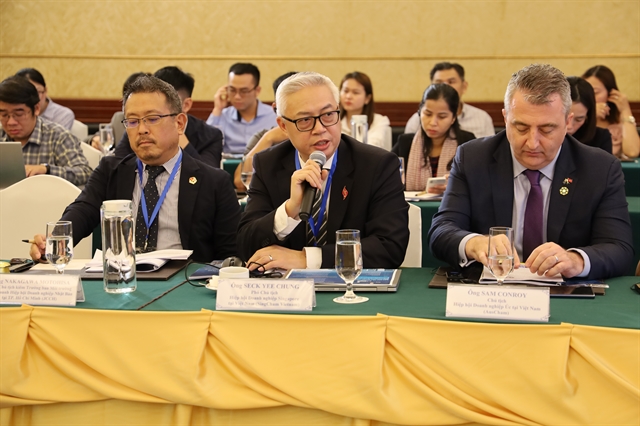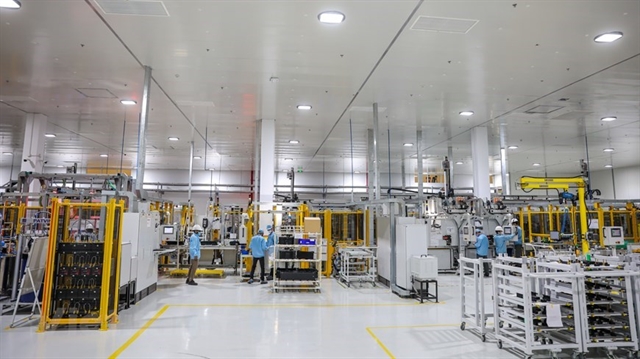 Economy
Economy

 |
| A battery production line of VinFast automaker in Việt Nam. There are not too many workers in the battery factory as most of the production process is done automatically by robots with the aim of gaining 100% accuracy. — Photo courtesy of Vietnam+ |
HÀ NỘI — As the number of electric vehicles (EVs) continues to rise globally, finding sustainable solutions for managing the batteries at the end of their life cycle is crucial for environmental and resource sustainability, and Việt Nam must be part of this, said experts.
Their comments were made at a workshop organised by the Vietnam Directorate for Standards, Metrology and Quality (STAMEQ), and the United Nations Development Program (UNDP) early this week to demonstrate the commitment of the Vietnamese Government and international organisations to tackle this issue.
By focusing on end-of-life-cycle solutions for EV batteries, they are recognising the importance of responsible disposal or recycling to minimise environmental impact and maximise resource recovery.
The workshop is part of a project "Expanding the scale of electric transportation and mechanisms to promote investment in green projects in Việt Nam," implemented by UNDP and supported by the Japanese Government, which indicates a collaborative effort to promote the adoption of EVs and develop a robust ecosystem for sustainable transportation in Việt Nam.
Hà Minh Hiệp, the Acting Director General of (STAMEQ) said, it seemed that Việt Nam had been making significant progress in the development of electric vehicles (EVs) and creating a supportive policy environment for their adoption. There had been an increase in the number of motor vehicles running on electricity in Việt Nam.
By the end of 2022, Việt Nam was expected to have around 2,000,000 electric motorbikes and 11,000 electric cars in operation. This indicated a growing acceptance and demand for EVs in the country. Additionally, there had been an increase in the number of electric buses and taxis in cities, which further promotes sustainable transportation options.
He also mentioned that Việt Nam's domestic electric vehicle industry had set ambitious plans to develop a complete ecosystem for EVs. This would include the provision of charging infrastructure and battery solutions, which are crucial for the widespread adoption of electric vehicles. By developing a comprehensive ecosystem, Việt Nam aimed to support the growth and sustainability of its electric vehicle industry.
Hiệp's statement highlights the potential benefits of increasing the use of hybrid vehicles, plug-in hybrid vehicles, and pure electric vehicles to reduce carbon emissions in the transportation industry. These vehicles utilise a combination of internal combustion engines and electric motors, which can lead to lower overall emissions compared to traditional gasoline-powered vehicles. However, the widespread adoption of electric vehicles also presents challenges related to battery management. Electric vehicle batteries have a limited lifespan, and their disposal can have environmental implications. To address this issue, battery recycling plays a crucial role. By recycling batteries, valuable minerals such as cobalt, nickel and lithium can be recovered, reducing the need for continuous mining and reducing the pressure on supply chains.
Dr. Nguyễn Sỹ Linh of the Ministry of Natural Resource and Environment told participants that Việt Nam was estimated to generate about 900,000 tonnes of hazardous waste. Of the figure, 20-30 per cent came from industries, while the agriculture sector generated about 9,000 tonnes and the medical sector, about 21,374 tonnes.
The National Strategy on Integrated Solid Waste Management by 2025 and towards 2050, as outlined in Decision 491/QĐ-TTg dated May 7, 2018, aims to strictly manage and control hazardous solid waste throughout its life cycle, from the source of waste generation to collection, transportation and final treatment.
One important aspect of the strategy is the encouragement of the construction of intensive treatment and recycling facilities for specific types of hazardous waste. This indicates a focus on developing specialised facilities that can handle hazardous waste in an environmentally sound manner.
The strategy also sets specific targets for the collection, transportation and treatment of hazardous waste. By 2025, the goal is to achieve a rate of 95 per cent of hazardous waste being collected, transported and treated according to regulations. By 2030, the target is even higher, aiming for a rate of 98 per cent. These targets indicate a commitment to improving the management and disposal of hazardous waste over time.
Đoàn Thị Thanh Vân, Head of the Electrical and Electronic Standards Department of the Vietnam Quality Standards Institute, released a statement saying all types of cell batteries, including lithium-ion, lithium-polymer and lead batteries, have certain environmental effects. The complexity of predicting or identifying these effects stems from the fact that they can occur at any stage of the battery's life cycle.
Việt Nam has established standards for the disposal of end-of-life-cycle batteries. These standards require that batteries at the end of their life cycle be managed in a way that avoids the release of hazardous substances into the environment. Additionally, all battery products must be collected when they reach the end of their useful life. Substances such as Ni-Cd, Ni-MH, and Li-ion should be reused or recycled to create new battery products.
She said it was important to implement appropriate collection and recycling practices to minimise the environmental impact of the substances found in waste batteries. This approach would not only help reduce the environmental impact but also contribute to material conservation.
Patrick Haverman, the Deputy Representative of UNDP Vietnam, said that as the demand for electric vehicles and electric vehicle batteries increased at the same time, the need for significant volumes of important raw materials also increased. To limit the environmental impact of EV batteries at the end-of-life-cycle phase, we would need to ensure that the product value is maximised through practices such as reusing, remanufacturing and recycling all associated components.
Haverman's statement highlights the potential benefits of circular economy policy approaches for various stakeholders in the electric vehicle (EV) battery manufacturing and industrial supply chain. Circular economy principles aim to minimise waste, maximize resource efficiency and promote sustainable practices throughout the product life cycle.
Also, at the seminar, Winter Ho, Senior Engineer of UL Solutions Taiwan, proposed that Việt Nam should develop a strategy to support battery reuse, including the use of standards such as UL 1974 and other IEC standards now being developed. In addition, it is recommended that Việt Nam should participate in the development of international standards through technical committees.
Koji Maehara, a representative of the Japan Automobile Manufacturers Association (JAMA), said that it was important to determine and fully implement the roles and responsibilities of the Government and the recycling industry and users in order to create a society working towards recycling through proper waste treatment. — VNS